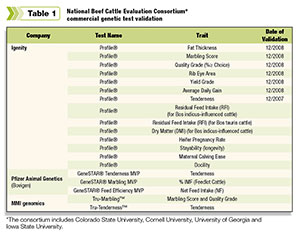“Life is specified by genomes,” says the National Center for Biotechnology Information. “Every organism, including humans, has a genome that contains all of the biological information needed to build and maintain a living example of that organism.
The biological information contained in a genome is encoded in its DNA and is divided into discrete units called genes.”
A genetic trait marker is a specific variation of DNA sequence that can be used to identify a particular difference in specific traits such as marbling or tenderness.
A summary of DNA tests validated by the National Beef Cattle Evaluation Consortium is presented in Table 1.
Click here or on the image above to view it at full size in a new window.
A majority of the current validated DNA tests are for either carcass quality or animal performance traits.
More than one genetic trait can be identified from a single sample, and the more tests a laboratory can conduct, the more information they can supply the customer.
Igenity can provide a comprehensive genetic profile on individual animals because of its ability to currently identify 12 different traits.
Selection of a laboratory should depend upon the type of desired information, economics and service.
“Genomic testing entails examination of hair, tissue, blood or semen samples to identify DNA markers,” says Gary Felger, technical manager for Igenity. “One way to collect a sample for DNA analysis is to pull a hair from the tail switch.
Tissue samples can be obtained from an animal’s ear with a sampling tool very similar to an ear-notching tool or by using a special ear tag that collects a small amount of tissue.
Blood samples are collected with a syringe from the vein beneath the tail head or by pricking a vein in the ear and dabbing the ear with a ‘blood card.’
A convenient time to collect DNA samples is when cattle are already being worked in the chute, such as during pregnancy testing or when vaccinating the herd.
Choice of the sample collection method depends upon personal preference and what is most efficient for your operation.”
Genomic tests enable better herd management
“We market our calves on a value-based system that pays a premium based on their performance in the feedyard and on the grid,” says Wayne Cockrell, manager of the Carter Ranch at Oakwood, Texas.
“By using higher-quality bulls, we moved our calves from 40 to 60 percent choice and then leveled off. I knew we weren’t going to make any more progress until we were able to improve our cow herd.”
Cockrell began taking hair samples from his cows and sending them to Igenity for genetic profile development.
He looks at the profile for each individual in two different ways – the cow’s ability to raise a good calf and the scores on growth and carcass traits.
Cockrell goes through the herd and rather than select the super-cows with the best genomic scores, he identifies the bottom 20 percent to cull.
“If I can select females that result in even a 5 percent increase in conception rates, I recover the cost of DNA profiling with improvement in fertility alone,” Cockrell explains.
“Then, when we look at long-term traits such as feed efficiency and all of the carcass traits, the investment more than pays for itself over the cow’s productive life.”
“Trich (bovine trichomonas) infected our commercial cattle herd and calving percentage dropped to 70 percent,” says Alton Hermes of Edna, Texas. “The disease plus the number of cattle we sold because of the 2011 drought drastically reduced our herd size.
Now that our area is receiving rain and the cattle are trich-free, we are rebuilding the herd by retaining heifers.”
Hermes says to ensure that he is keeping the right females, all first-bred heifers are DNA tested for reproductive capabilities.
If test results show that a heifer doesn’t have the genetics to be a good brood cow, then she is sold as a feeder. “We cannot afford to feed an animal that will not produce and DNA profiling allows us to make early culling decisions,” he said.
“I believe more ranchers need to think about the type of beef a consumer wants on their dinner plate,” says Dennis Kaspar at Shiner, Texas.
“My goal is to produce a beef carcass that is uniform and consistent in quality. To help accomplish that goal, every cow, calf and bull on the ranch is DNA profiled. Animals that don’t have the potential to produce good-quality beef are culled.”
DNA sampling requires very little time
“At first, I was apprehensive about collecting DNA samples and the additional work it would add to our processing routines,” says Cockrell.
“However, the tissue collection device is very easy to use and doesn’t slow us down at all. While an animal is in the squeeze chute we get a tissue sample from an ear with the collection pliers. It only takes seconds.”
“We take tissue samples for DNA profiling at the time we palpate our heifers and attach tags to their ears,” says Hermes. “The extra task of tissue sampling adds only seconds to the processing time.”
“Every time we work cattle, tissue samples are taken from animals that have not previously been DNA profiled,” says Kaspar. “The time it takes is not even noticeable. DNA profiling is a great tool for herd improvement and taking the samples is easy and fast.”
Robert Fears is a freelance writer based in Texas.
PHOTO
DNA blood samples can be collected with a syringe from the vein beneath the tail head. Photo courtesy of Ellen R. Jordan.










